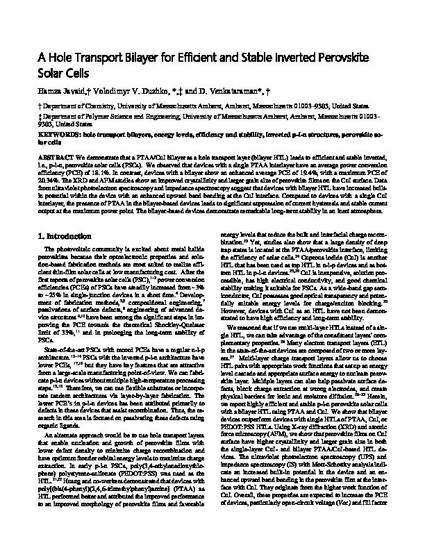
Article
A Hole Transport Bilayer for Efficient and Stable Inverted Perov-skite Solar Cells
ACS Appl. Energy Mater.
(2020)
Abstract
We demonstrate that a PTAA/CuI bilayer as a hole transport layer (bilayer HTL) leads to efficient and stable inverted, i.e., p-i-n, perovskite solar cells (PSCs). We observed that devices with a single PTAA interlayer have an average power conversion efficiency (PCE) of 18.1%. In contrast, devices with a bilayer show an enhanced average PCE of 19.4%, with a maximum PCE of 20.34%. The XRD and AFM studies show an improved crystallinity and larger grain size of perovskite films on the CuI surface. Data from ultraviolet photoelectron spectroscopy and impedance spectroscopy suggest that devices with bilayer HTL have increased built-in potential within the device with an enhanced upward band bending at the CuI interface. Compared to devices with a single CuI interlayer, the presence of PTAA in the bilayer-based devices leads to significant suppression of current hysteresis and stable current output at the maximum power point. The bilayer-based devices demonstrate remarkable long-term stability in an inert atmosphere.
Keywords
- hole transport bilayers,
- energy levels,
- efficiency and stability,
- inverted p-i-n structures,
- perovskite solar cells
Disciplines
Publication Date
Fall December 30, 2020
DOI
doi.org/10.1021/acsaem.0c01806
Citation Information
Dhandapani Venkataraman. "A Hole Transport Bilayer for Efficient and Stable Inverted Perov-skite Solar Cells" ACS Appl. Energy Mater. Vol. 4 Iss. 1 (2020) p. 72 - 80 Available at: http://works.bepress.com/d_venkataraman/6/
